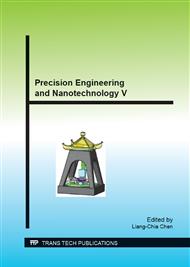p.564
p.570
p.576
p.581
p.587
p.593
p.597
p.603
p.607
Influence of Ultrasonic Assisted Processing on the Ductility of Binderless Tungsten Carbide
Abstract:
For the production of mould inserts for precision glass moulding, the ultra precision grinding technique with a subsequent manual polishing operation is typically applied. These processes are time consuming and have a relatively low reproducibility. An alternative manufacturing technology, with a high predictability and efficiency, which additionally allows a higher geometrical flexibility, is the diamond turning technique. In addition the ultrasonic assisted ultra precision cutting process has already proven its potential for machining difficult-to-cut materials, such as steel and glass. By applying the ultrasonic assistance, the classic constraints of the process can be widened significantly. In this publication the process is applied on binderless, nanocrystalline tungsten carbide.
Info:
Periodical:
Pages:
587-592
Citation:
Online since:
August 2014
Authors:
Price:
Сopyright:
© 2015 Trans Tech Publications Ltd. All Rights Reserved
Share:
Citation:


